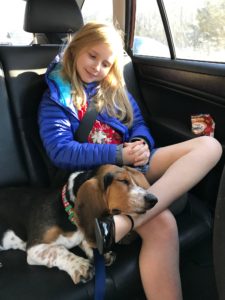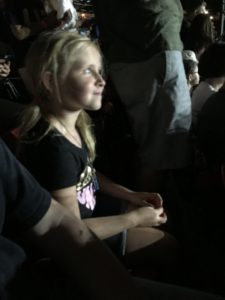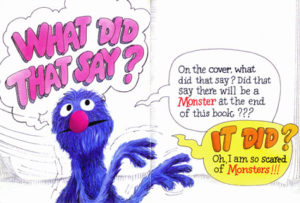Storytelling, Writing Advice
Show and Tell
As a parent, I can assure you the old “show and tell” exercise from elementary school is still going strong. Kids bring in a treasured toy or other artifact from home and stand before the class to explain it. As a writer, I see the old adage, “Show, don’t tell,” remains in the top five of writer advice maxims. But our kindergarten teachers were correct all along. It’s show AND tell, not show all by itself. You need both to tell an effective story, and the secret is in the balance of the two. But which is which? And how do you know when to show and when to tell?
A good rule of thumb is that the bulk of “telling” often comes between scenes to establish time, place, setting, mood, and so forth. Then there are bits of telling interspersed when you want to make a quick point but don’t want to weigh down the action. I’ve illustrated an example below with the scene where we meet Annalisa Vega in Gone for Good:
Detective Annalisa Vega had sworn off dating when the third guy in a row ended the evening by asking to see her handcuffs. Or maybe her stomach had turned during the last homicide she’d worked, in which the ex-husband blew out a glass door with a double-barreled shotgun, hunted down his terrified wife, and executed her as she cowered next to the bed they’d once slept in together. Hard to make upbeat chitchat over apps and cosmos after viewing the remains of a relationship like that. [This is pure telling. Establishes voice, character background, and POV.]
This guy is different, Sassy had assured her when she’d arranged the setup. I know him from church, which he attends with his mother. But don’t worry—he doesn’t live with her. Lured out from her reclusive lair by this ringing endorsement, Annalisa now regarded her date across the narrow two-person table and tried again to sell herself on his numerous good points. Todd Weatherby, tax attorney, had a full head of dark hair, nice teeth, no food on his tie, and he’d selected a lovely Wicker Park restaurant for their first date. Italian, with cloth napkins and a real candle flickering on the table. Her mother would be over the moon for him. [Still mostly telling!]
Annalisa wasn’t sure if this last point was for or against Todd Weatherby. Her mother, who had been positively apoplectic when Annalisa had up and married a cop at the tender age of twenty-one, now reminded her constantly that “the clock is ticking” since she had turned thirty. [Yep, here we are on the third paragraph with more telling. Why so much telling? We could leap in earlier with the conversation, but the set-up gives you a reason to care about it. By the time Annalisa and her date begin speaking, we already know she’s impatient for a real relationship and skeptical that this guy is The One. So we’re interested to see if her assessment is correct.]
“Annalisa is a pretty name,” Todd said gamely. “Is it Spanish?” [This starts the showing. We ‘see’ this conversation taking place rather than having it relayed to us.]
“Portuguese.” Her great-grandfather’s grandfather had emigrated to New Bedford in Massachusetts in the mid-1800s when the city boomed thanks to a thriving whaling industry. Family lore said Great Grandpapa Vega had once worked alongside Herman Melville, but Annalisa suspected this was just a fish story. Whatever the case, her own great-grandfather had jumped ship and moved west to Chicago to cash in on the surge of construction after the Great Fire. The Vegas hadn’t budged in the hundred years since, living and dying within the city limits like the place had a wall around its borders. [Here is a bit of telling mixed in with the showing.]
“Todd is a nice name,” she offered. “Is it, um . . . English?”
“Maybe? I’m named after my uncle. He runs a button manufacturing plant in New Jersey. Did you know buttons date back to almost 3000 BC? Their earliest known use was in Indonesia, back when they were made from shells. But later . . .” [More showing. Rather than telling the reader Annalisa is bored, we see her lack of interest in Todd’s topic of conversation.]
She repressed a yawn and drifted away inside her head. Maybe next time she could ask Sassy to recommend a good movie or a talented masseuse. I should just accept my destiny and adopt a cat, she thought. Or maybe two. They could keep each other company while she was at work. Todd was still talking, and she forced herself to focus on his words. He had his wine glass in the air as if to make a toast. Obligingly, she lifted hers as well. “To us,” he said. “We are fated to be together always.”
“Uh . . . what?” She held her glass back. [This is a pointed bit of showing. Annalisa taking back her glass from the toast shows us her unpleasant shock at Todd’s words.]
“Us,” he repeated, looking chagrined as he motioned between them. “You know—death and taxes. We’re inescapable!” He grinned at his own joke about their respective careers, and her smile became frozen in place. “Get it?” he prodded.
“Oh, I got it.”
He cleared his throat. “Are you interested in the dessert menu?”
Decision time. Ticktock. He looked at her with hopeful eyes. She knew she could do a lot worse, but she didn’t want a lackluster relationship just to say she had one. She wanted her parents’ marriage, soul mates for forty-four years and counting. George and Maria still held hands under the dinner table. Meanwhile, Annalisa went on these going-nowhere dates, making talk so small she needed a microscope to parse it. Her ideal dessert at this point was a pint of Ben & Jerry’s, alone, curled up on her couch with a Netflix backlog. “I— ” In her purse, her work phone started to chirp, and she pulled it out for a look. Dispatch had sent a text asking her to call in, Code 10-54. A body. “Oh,” she said with what she hoped sounded like regret, “I’m sorry, I’ve got to go. It’s work.”
“Work? Even at this hour?”
She was already gathering her things. “Homicide doesn’t punch a time card,” she declared, maybe too cheerfully.
Todd deflated in his chair, unable to argue with this truism. “Death,” he said glumly, taking up his glass again. “It’s inescapable.” [Poor Todd. I don’t think he’s met his love match.]
In short, you need “telling” in your writing to impart backstory, inject character inner narrative, and to keep the action moving along. Use showing to illustrate key plot developments, emotion, and characterization. But, contrary to most advice out there, you absolutely do need both.











